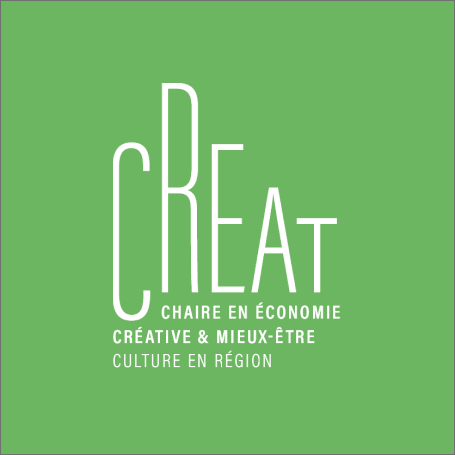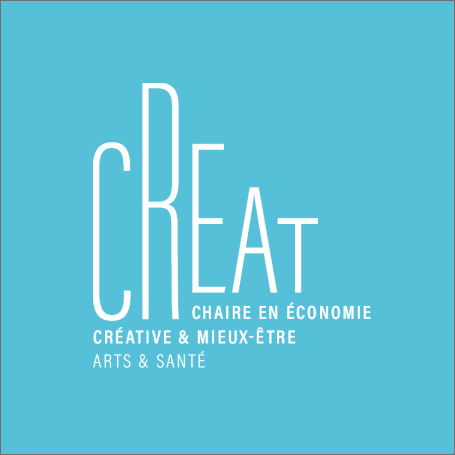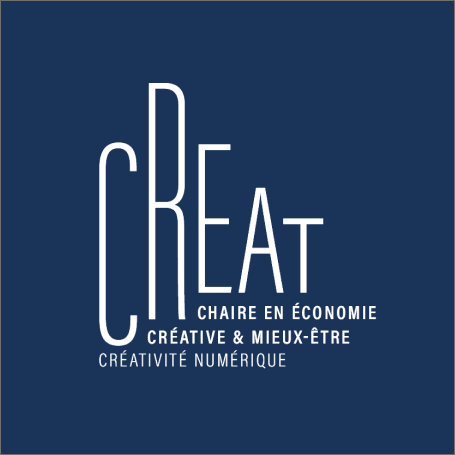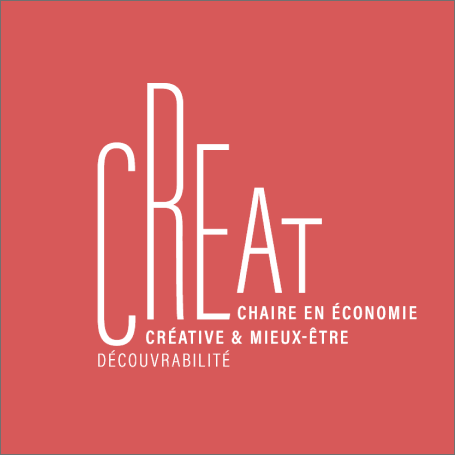About
About the RESEARCH CHAIR IN THE CREATIVE ECONOMY AND WELL-BEING (CREAT)
The research chair in the creative economy and well-being (CREAT) is built on the idea of intermediation. Intermediation implies the involvement of third parties, groups and institutions, in order to create dialogue, bring people together, connect and transform. More specifically, the CREAT contributes to the creation of a network of multiple players to enable everyone, no matter their location, digital literacy or lifestyle, to access a form of well-being.
Quebec already possesses a wealth of creative resources, and its population has achieved a certain level of well-being. However, all too often, initiatives, knowledge and works are scattered and remain confidential and inaccessible. The CREAT Chair brings together diverse realities and disciplines (interdisciplinarity).
The team consists of Julie Bérubé (Culture in the regions Axis), Olivier Beauchet (Arts and Health Axis), Laureline Chiapello (Digital Creativity Axis) and Guillaume Blum (Discoverability Axis).
The research chair in the creative economy and well-being (CREAT) aims to create an ecosystem of researchers, practitioners, creators and partner organizations, in order to establish Quebec’s leadership in stimulating the creative economy and in well-being. CREAT activities serve a wide range of audiences, from the academic world to practical and political circles.
Dissemination activities include summer schools, festival, conferences, publications, and scientific communications (open access articles, special issues of scholarly journals, scientific conferences, etc.). In the near future, the Chair will offer online training, podcasts, seminars, and creative workshops. More than just a research project, the Chair is an infrastructure committed to research and to disseminating its results to promote individual, collective, and societal well-being.
THE CHAIR’S MISSION AND OBJECTIVES
The Chair’s mission is to identify and respond to the issues and challenges of the creative economy and wellness, particularly in the fields of Culture in the regions, Art and health, Digital Creativity and Discoverability.
The main objectives for each of the Chair’s four (4) axis are as follows:

 CULTURE IN THE REGIONS
CULTURE IN THE REGIONS
The main objective of this axis is to promote and foster research and creative and cultural initiatives in the regions, i.e. outside the major urban centres. Read More >

 ARTS AND HEALTH
ARTS AND HEALTH
Encourage and undertake research, training and knowledge-transfer initiatives to better understand the relationship between arts, culture and health, and to facilitate knowledge transfer, in order to find answers to the challenges and issues facing society. Read More >

 DIGITAL CrEativitY
DIGITAL CrEativitY
Identify crucial issues within the digital creative industries, particularly in visual effects (VFX) and animation, video games and digital experience (Xn) areas, to foster research, training and development in this sector. Read More >

 DISCOVERABILITY
DISCOVERABILITY
Contribute to understanding the dynamics behind discoverability issues, disseminate knowledge on the subject and propose modes of action based on research. Conduct all of this at the individual, collective and societal levels concerning culture and, more broadly, “products” from the creative economy and ideas that enhance well-being, particularly—but not exclusively—on digital platforms. Read More >

CHAIR COMMITTEES
The CREAT Chair relies on the close collaboration of four (4) committees that actively contribute to the Chair’s activities.
Executive Committee
The role of the Executive Committee is to ensure that the Chair’s orientations, choices and activities are in line with its mission. The Executive Committee represents the highest decision-making level of the Chair
Scientific Committee
The Scientific Committee advises the Chair’s holders on the development and implementation of the Chair’s scientific program. It ensures compliance with ethical rules and data quality control, while helping to set and maintain collectively established priorities.
Axis Committees (4)
The role of the Axis Committees is to ensure that the objectives of each axis, as defined by the Chair’s governance, are achieved.
Student Advisory Committee
The Student Advisory Committee brings together students recognized by the Chair’s four (4) axis committees.

CHAIR Co-HEAD
JULIE BÉRUBÉ
Head of Culture in the regions
> Write to Julie Bérubé
OLIVIER BEAUCHET
Head of Arts & Health
> Write to Olivier Beauchet
LAURELINE CHIAPELLO
Head of Digital Creativity
> Write to Laureline Chiapello
GUILLAUME BLUM
Head of Discoverability
> Write to Guillaume Blum
Coordinators
CREAT has one person in charge of coordinating each axis as well as one person responsible for the overall coordination of the Chair.
MAUD LORANGER
General Coordinator CREAT
> You can email Maud Loranger here.
NAOMIE ALLARD
Culture in the regions & Digital Creativity Coordinator
> You can email Naomie Allard here.
KEVIN GALERY
Arts and Health Coordinator
> You can email Kevin Galery here.
SACHA SIARY
Discoverability Coordinator
> You can email Sacha Siary here.
Co-researchers and collaborators
The research chair in the creative economy and well-being (CREAT) brings together a vast team of 53 researchers and 65 collaborators in 8 countries outside Canada.
These partners include the following institutions:
> 2 CÉGEPs
Dawson College and Cégep de Rivière-du-Loup – LLIO
> 14 Quebec universities
Université Concordia, HEC Montréal, Université McGill, INRS, TELUQ, Université de Montréal, Université Laval, UQAC, NAD-UQAC, UQAR, UQAM, UQAT, UQO, UQTR
> 5 Canadian universities from outside Quebec
Université de Saint-Boniface (Manitoba), University of Waterloo (Ontario), Université St-Paul (Ontario), Toronto University (Ontario), Université d’Ottawa (Ontario)
> 17 international universities
Université Côte d’Azur (France), Université de Bordeaux (France), Université de Séville (Spain), Université de Versailles Saint-Quentin-en-Yvelines (France), Université Nantes (France), Université Paris Sorbonne Nouvelle-IRCAV (France), Université Paris-Nord (France), Université Rennes 1 (France), The Ohio State University (USA), Paul-Valéry Montpellier III (France), ENSAE (France), Universidad San Francisco de Quito (Ecuador), Nanyang Technological University (Singapor), NYU Steinhart (USA), Oxford University + WHO (UK), Harvard University (USA)
> 50 practice environments
located in Quebec unless, otherwise noted
Arts alive Tokyo (Japan), Centre Bang, CHU de Rouen (France), Cleveland Clinic (USA), Compétence Culture, CRDIN, CRIUGM, Culture Capitale nationale et Chaudières-Appalache, Culture Côte-Nord, Culture Estrie, Culture Gaspésie, Culture Lanaudière, Culture Laurentides, Culture Laval, Culture Montérégie, Culture Outaouais, Culture pour tous!, Culture Saguenay Lac-Saint-Jean, École de cirque de Verdun, École nationale de théâtre du Canada, Espace pour la vie, EXEcentrer, Fédération québécoise des sociétés Alzheimer, Galerie UQO, GMF, Institut du Monde Arabe (France), Laboratoire Ex situ, La Sams, Maison de l’innovation sociale, MNBAQ, Mouvement des accélérateurs d’innovation du Québec, Musée de la civilisation, Musée de la Gaspésie, Musée McCord Stewart, Musée régional de l’Outaouais, OMS, Orchestre symphonique de Montréal, Place courage, PME MTL, Pôle entrepreneuriat culturel et créatif, Réseau des conseils régionaux de la culture du Québec, Sinapses Conseils – Club Innovations et Cultures (France), Société des arts technologiques, SODEC, Sporobole, Synapse C, Teatro Villa Mayor of Bogota (Colombia), Théâtre du Nouveau Monde, Ville de Gatineau, World Design Organization
